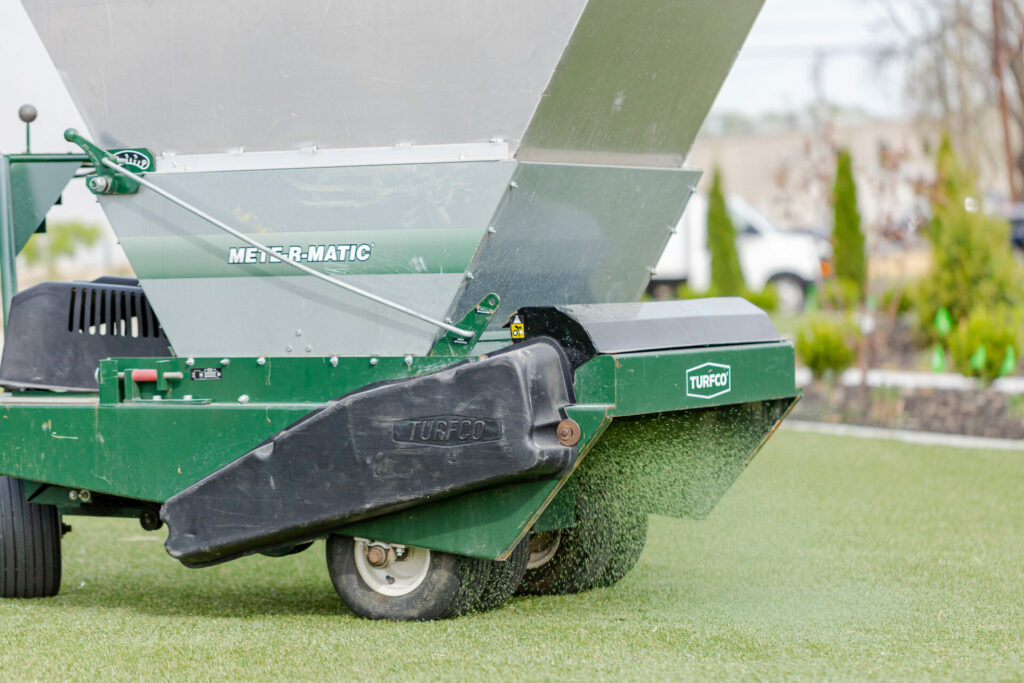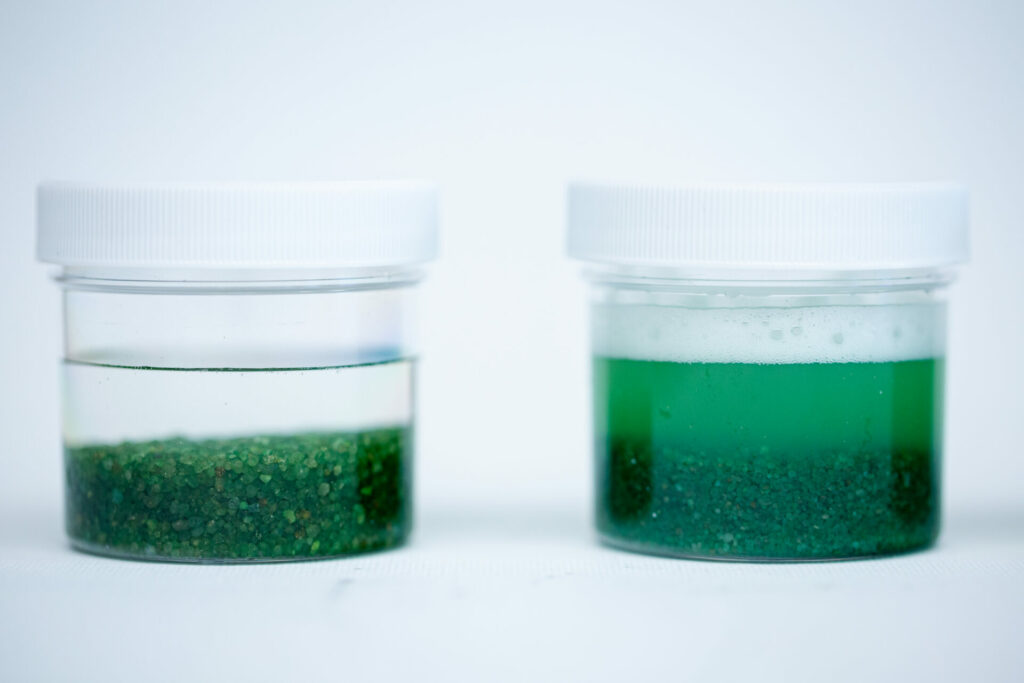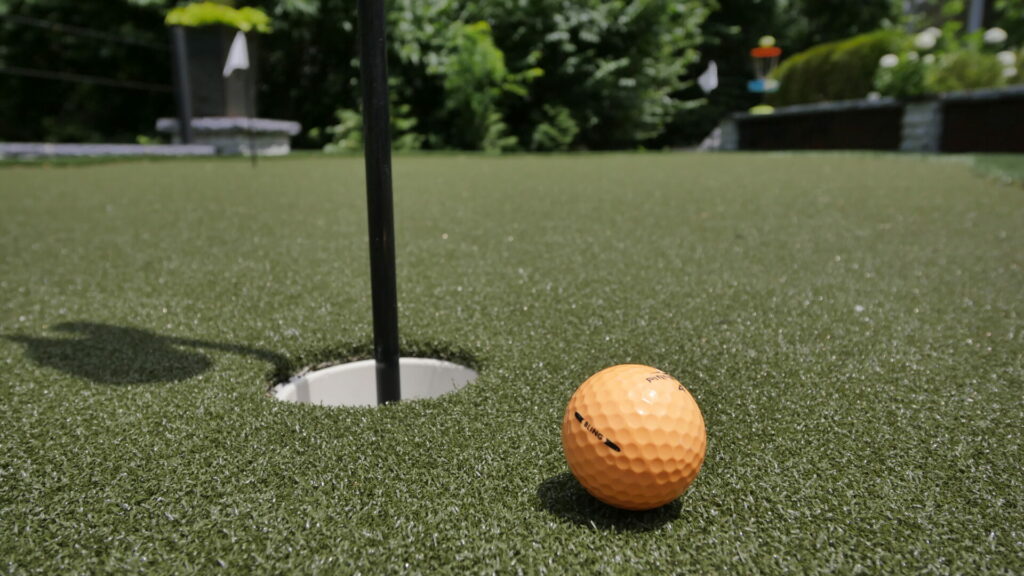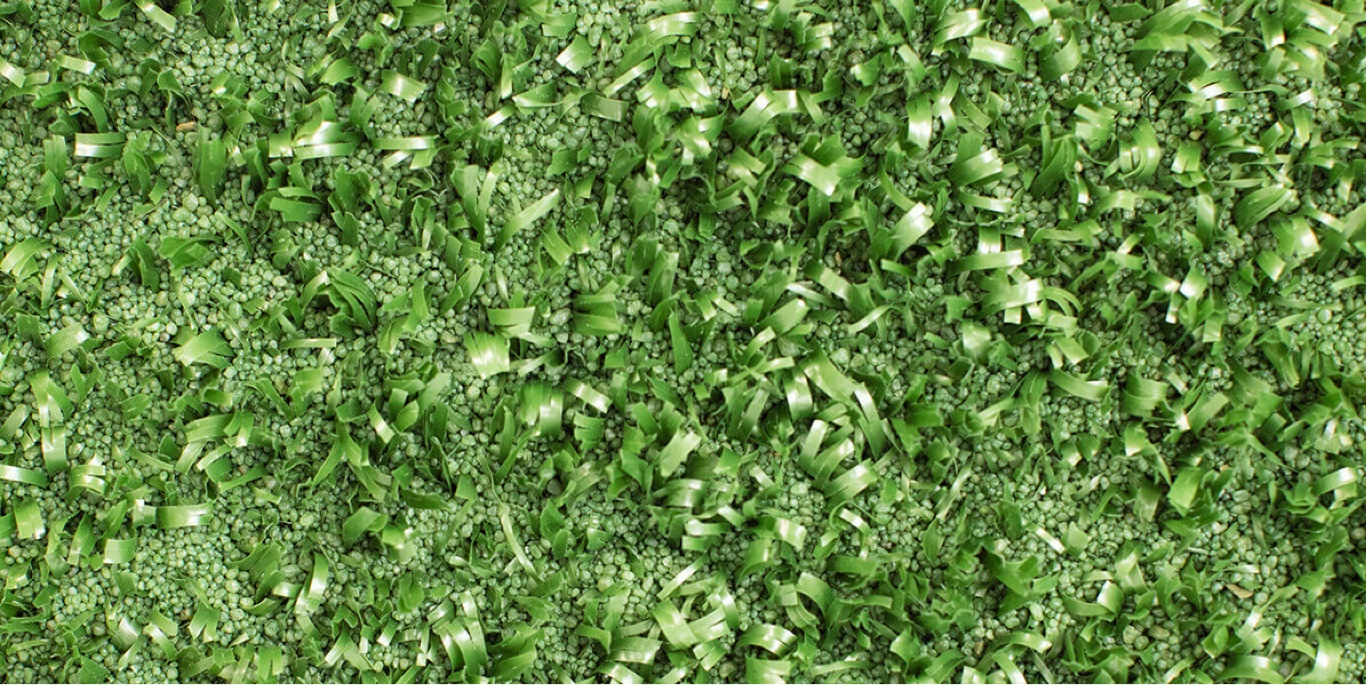
Infill Landscape Blog
Subscribe To Email Updates
Subscribe to our weekly newsletter and we’ll send updates straight to your inbox
My Artificial Turf Smells Like Dog Pee – What Should I Do?
A lot of folks with synthetic grass lawns say they love how low maintenance their turf is. But for those with a Fido afoot, TLC will sometimes be needed to eliminate a common turf issue for dog owners. We’re talking about the smell that happens when artificial turf and dog urine mix.
Artificial turf is famously pet-friendly — and, just as important, pet owner-friendly. By opting for turf and a safe, non-toxic synthetic turf infill for your lawn (or your dog park!), your green space is guaranteed to look, well, green, no matter how many bathroom breaks your pup is taking. As a pet owner, artificial turf gives you very little to worry about — unless things start to get smelly. Foul odors make it hard to enjoy the outdoor space you’ve invested so much time and planning into, which can ultimately mean less time outside for both you and your dog.
Below, we break down why dog urine can sometimes lead to smelly turf, the steps you can take if this happens, and how to prevent it going forward.
What’s causing my artificial turf to smell like dog urine?
The short answer: urea.
Urea is a waste product that the body — human or canine — produces as it breaks down amino acids. Those acids metabolize into ammonia and carbon dioxide — and ammonia, in particular, is incredibly toxic when stored in the body in large amounts. By turning these toxic byproducts into urea, the body can safely move them through the bloodstream and kidneys and expel them as urine.
What Happens to Artificial Turf When Dogs Pee?
Unfortunately, after exiting the body, that’s when things start to get a little — well, stinky. Over time, urine residue will slowly release ammonia back into the air, which is directly responsible for that smell. Although artificial turf is designed to have much better drainage than natural grass, when a dog constantly uses the same stretch of turf as their toilet, all that urea-filled urine can build up in the turf’s individual layers.
A quality synthetic turf infill is crucial to preventing odor buildup. But not all infills are created equal. For instance, raw sand — one of the most common infills used in turf landscaping — can actually make urine smells worse. This is because sand traps urine, which prevents it from draining quickly through your turf system. You’ll want to pick an infill that optimizes your turf’s drainage abilities, as well as one that helps eliminate odor-causing organic growth and bacteria.
How to Get Dog Urine Smell Out of Artificial Grass Immediately
Prevention (or rather, management) is the best cure. So, potty-train your dog, and clean your turf regularly! But accidents do happen, so if you need a quick fix, take these steps immediately:
1. Remove solid waste
If there is any solid waste on the grass, it’s vital to remove it first to prevent further contamination.
2. Hose down the area
Use a garden hose to rinse the affected area with water, flushing out any lingering urine or feces that may be stuck between the grass blades.
3. Apply a vinegar solution or enzyme-based cleaner
Mix equal parts of vinegar and water and spray the solution on the affected areas for an environmentally-friendly, natural disinfectant and deodorizer.
If you want to use something more powerful, use an enzyme-based cleaner. These contain enzymes and live bacteria that break down the source of the ammonia odors.
4. Let the solution sit
To neutralize the odor, allow the solution to sit on the grass for five to ten minutes. If you’re using a different cleaner, follow the directions on the bottle.
5. Rinse
Once the solution has worked, thoroughly rinse the area with water.
6. Apply a turf deodorizer (optional)
If the odor persists after cleaning, sprinkle a natural turf deodorizer, such as baking soda, on the affected area and let it sit for 20 minutes before sweeping or vacuuming. Baking soda is amazing for removing the worst of odors–Fido’s pee included.
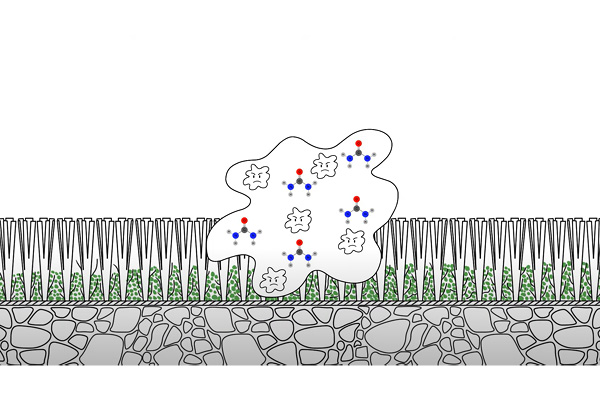
How do I stop my artificial grass from smelling? 4 steps to take
It’s time and labor-intensive to always have to spray baking soda on your turf every time your dog decides to mark on it. There’s a better, more lasting solution: deep cleaning.
Every situation is different, but first, check to see if your turf installer used infill, as well as what kind of infill they went with. From there, you’ll be better equipped to address the root cause of your turf’s smell. Unfortunately, there’s no one “magic cure” for fixing stinky turf — it’s, at the end of the day, a multi-step process. But for those who are willing to start from scratch and deep clean their turf, rest easy that the smell can be improved. Below, we walk you through how to do just that.
1. Vacuum out old infill.
This is probably the most time-consuming step to getting your turf free of noxious smells. More than likely, if you used a different infill before switching to an anti-odor brand, the old residual infill could be responsible for lingering bad smells. The best solution is to install an odor-fighting infill, like Envirofill, in the first place. That’s because adding an odor-fighting infill on top of your old, smelly infill won’t fix matters. If you are in the position of switching between infills, though, do everything you can to get out the old gunk before putting in your new infill.
2. Deep clean your turf’s fibers once the old infill is removed.
For turf that’s smelling a bit too much like dog pee for your liking, use an enzyme-based solution to give it a good deep clean. Enzymes are essential because uric acid, urea’s similarly ammonia-rich counterpart, is not water-soluble — meaning water alone won’t help you eliminate it. An enzyme-based solution will speed up the ammonia production that’s already happening, helping it (and that pesky smell) to evaporate quickly.
Most enzyme cleaners can be hooked up to a hose and, along with water, used to soak your yard. It may take more than one application of cleaner, so wait until things get to an “acceptable” odor level before moving on to the next step. Trying to get your turf’s smell as close to square one as possible is key here.
Note also that most enzyme cleaners don’t require any brushing or scrubbing — just a simple rinse. If brushing does seem necessary, you’ll want to check with your turf installer beforehand to be sure you won’t damage your turf’s fibers.
Finally, let your turf dry thoroughly, as installing an infill with moisture present can be challenging.
3. Install Envirofill.
Envirofill is the only synthetic turf infill on the market that’s infused with Microban antimicrobial technology, helping it to reduce ammonia and fight against odor-causing bacteria, mold, and mildew. In fact, Envirofill has been shown to reduce ammonia odor from urine by up to 99%, given it disrupts the bacterial process that converts pet urine into ammonia odors. And because Envirofill is coated, that keeps its otherwise-porous sand granules from harboring and growing bacteria from the inside. All together, that means the properties of your infill are working 24/7 to keep your yard clean — and smelling clean, too.
For the full anti-odor effect of Envirofill, be sure to use the recommended amount of two to three pounds of infill per square foot, at a minimum. Sticking to just one pound of infill per square foot of turf won’t provide enough coverage to fight off odors.
4. Perform regular cleaning and maintenance.
For starters, you’ll want to rinse your turf regularly using an enzyme-based cleaning agent — a bit more often if you have multiple dogs. Beyond the number of dogs, other factors can contribute to how likely your dog’s urine is to cause turf odors, too, including the amount of sun, rain, and humidity your yard gets; the kind of food your dog eats; your dog’s gender and size; and how sensitive you, as the homeowner, are to the smell of ammonia, to begin with.
At a minimum, you’ll want to rinse off your turf once a month. It could be rinsed as frequently as once a week, though, particularly if you live somewhere that doesn’t get much rain and have big dogs using a smaller yard. At the end of the day, it all comes down to what makes you — and your nose! — most comfortable.
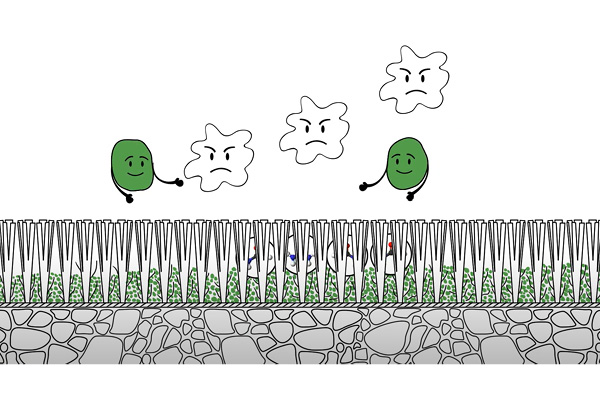
FAQs: What you need to know once your artificial turf starts to smell of dog pee
1. How often should I clean fake grass from dog urine?
About once a week.
2. Can dogs pee and poop on artificial grass?
Yes. Pets can poo and pee on artificial grass, as the waste doesn’t sink into the ground, making cleaning up much easier than on natural grass.
3. Does artificial turf have harmful chemicals for dogs?
No. There are some older types of artificial turf that contain infill materials like crumb rubber, which can contain harmful chemicals. Nowadays, most artificial turf infill is made from non-toxic materials– for example, Motz’s Safeshell infill is made from 100% USA-grown walnut shells, making it better for people and the planet. Always check with the manufacturer to ensure the product you’re considering is safe.
4. Does dog pee ruin fake grass?
No. Dog pee does not ruin fake grass. Artificial grass is designed to be durable and resistant to urine, though the urine can leave a smell if not properly cleaned, which is why regular maintenance is important.
5. How do I maintain my turf?
Here are some best practices for maintaining your synthetic turf:
1. Groom the infill and turf regularly
Keep the infill even and upright by regularly combing it, ensuring sound footing and aesthetic appeal. Avoid metal fibers when using nylon or polypropylene bristles and comb-like attachments. In high-traffic areas, you may need to add more infill over time to support the turf.
2. Disinfect the surface periodically
The synthetic turf field can collect sweat, spit, pee, and blood from pets and humans, so it is important to disinfect the field periodically. Sprinkle baking soda on the turf, especially in areas with stubborn odors or stains, and sweep or vacuum it up after about 20 minutes. This natural, inexpensive deodorizer works both to neutralize odors and remove stains.
3. Repair seams when required
Spot and repair broken seams early to prevent further damage or potential injuries. Your turf company may offer a warranty covering seam repairs within a specific timeframe.
4. Regularly remove stains and debris
When grooming the turf, use equipment that sweeps and magnetically picks up debris, such as screws or nails. For stubborn stains, use approved cleaners and avoid gum and sunflower seeds on the field. You should take the advice of your turf company when approaching this, as different types of turfs have their own special needs.
Similar Blogs
